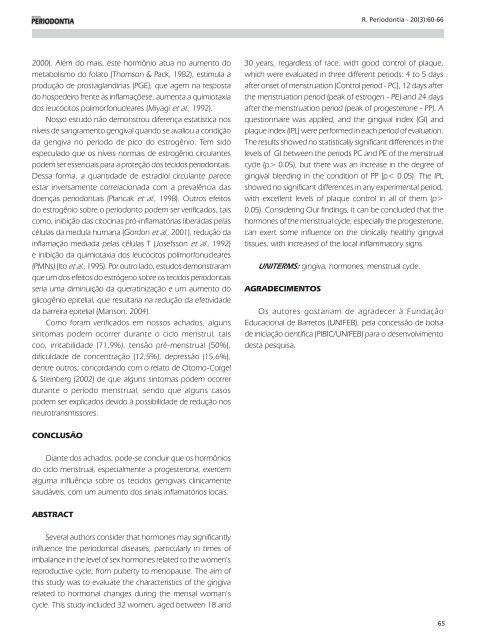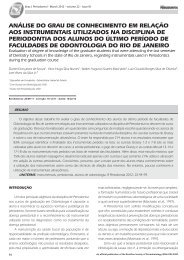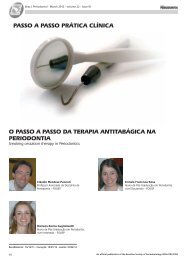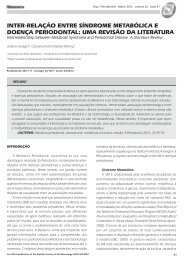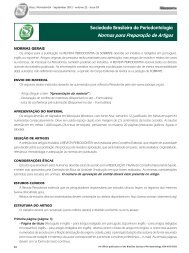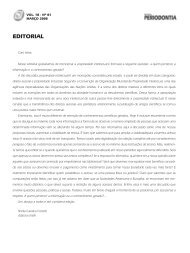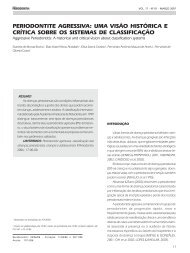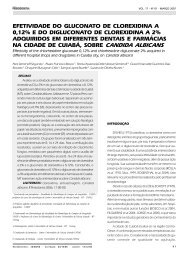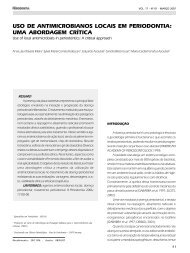revista perio set2010 - 3ª REV - 31-01-11.indd - Revista Sobrape
revista perio set2010 - 3ª REV - 31-01-11.indd - Revista Sobrape
revista perio set2010 - 3ª REV - 31-01-11.indd - Revista Sobrape
Create successful ePaper yourself
Turn your PDF publications into a flip-book with our unique Google optimized e-Paper software.
R. Periodontia - 20(3):60-66<br />
2000). Além do mais, este hormônio atua no aumento do<br />
metabolismo do folato (Thomson & Pack, 1982), estimula a<br />
produção de prostaglandinas (PGE), que agem na resposta<br />
do hospedeiro frente às inflamaçõese, aumenta a quimiotaxia<br />
dos leucócitos polimorfonucleares (Miyagi et al., 1992).<br />
Nosso estudo não demonstrou diferença estatística nos<br />
níveis de sangramento gengival quando se avaliou a condição<br />
da gengiva no período de pico do estrogênio. Tem sido<br />
especulado que os níveis normais de estrogênio circulantes<br />
podem ser essenciais para a proteção dos tecidos <strong>perio</strong>dontais.<br />
Dessa forma, a quantidade de estradiol circulante parece<br />
estar inversamente correlacionada com a prevalência das<br />
doenças <strong>perio</strong>dontais (Plancak et al., 1998). Outros efeitos<br />
do estrogênio sobre o <strong>perio</strong>donto podem ser verificados, tais<br />
como, inibição das citocinas pró-inflamatórias liberadas pelas<br />
células da medula humana (Gordon et al., 20<strong>01</strong>), redução da<br />
inflamação mediada pelas células T (Josefsson et al., 1992)<br />
e inibição da quimiotaxia dos leucócitos polimorfonucleares<br />
(PMNs) (Ito et al., 1995). Por outro lado, estudos demonstraram<br />
que um dos efeitos do estrógeno sobre os tecidos <strong>perio</strong>dontais<br />
seria uma diminuição da queratinização e um aumento do<br />
glicogênio epitelial, que resultaria na redução da efetividade<br />
da barreira epitelial (Manson, 2004).<br />
Como foram verificados em nossos achados, alguns<br />
sintomas podem ocorrer durante o ciclo menstrul, tais<br />
coo, irritabilidade (71,9%), tensão pré-menstrual (50%),<br />
dificuldade de concentração (12,5%), depressão (15,6%),<br />
dentre outros; concordando com o relato de Otomo-Corgel<br />
& Steinberg (2002) de que alguns sintomas podem ocorrer<br />
durante o período menstrual, sendo que alguns casos<br />
podem ser explicados devido à possibilidade de redução nos<br />
neurotransmissores.<br />
30 years, regardless of race, with good control of plaque,<br />
which were evaluated in three different <strong>perio</strong>ds: 4 to 5 days<br />
after onset of menstruation (Control <strong>perio</strong>d - PC), 12 days after<br />
the menstruation <strong>perio</strong>d (peak of estrogen - PE) and 24 days<br />
after the menstruation <strong>perio</strong>d (peak of progesterone - PP). A<br />
questionnaire was applied, and the gingival index (GI) and<br />
plaque index (IPL) were performed in each <strong>perio</strong>d of evaluation.<br />
The results showed no statistically significant differences in the<br />
levels of GI between the <strong>perio</strong>ds PC and PE of the menstrual<br />
cycle (p> 0.05), but there was an increase in the degree of<br />
gingival bleeding in the condition of PP (p< 0.05). The IPL<br />
showed no significant differences in any experimental <strong>perio</strong>d,<br />
with excellent levels of plaque control in all of them (p><br />
0.05). Considering Our findings, it can be concluded that the<br />
hormones of the menstrual cycle, especially the progesterone,<br />
can exert some influence on the clinically healthy gingival<br />
tissues, with increased of the local inflammatory signs.<br />
UNITERMS: gingiva, hormones, menstrual cycle.<br />
AGRADECIMENTOS<br />
Os autores gostariam de agradecer à Fundação<br />
Educacional de Barretos (UNIFEB), pela concessão de bolsa<br />
de iniciação científica (PIBIC/UNIFEB) para o desenvolvimento<br />
desta pesquisa.<br />
CONCLUSÃO<br />
Diante dos achados, pode-se concluir que os hormônios<br />
do ciclo menstrual, especialmente a progesterona, exercem<br />
alguma influência sobre os tecidos gengivais clinicamente<br />
saudáveis, com um aumento dos sinais inflamatórios locais.<br />
ABSTRACT<br />
Several authors consider that hormones may significantly<br />
influence the <strong>perio</strong>dontal diseases, particularly in times of<br />
imbalance in the level of sex hormones related to the women’s<br />
reproductive cycle, from puberty to menopause. The aim of<br />
this study was to evaluate the characteristics of the gingiva<br />
related to hormonal changes during the mensal woman’s<br />
cycle. This study included 32 women, aged between 18 and<br />
65<br />
<strong>revista</strong> <strong>perio</strong> <strong>set2<strong>01</strong>0</strong> - 3ª <strong>REV</strong> - <strong>31</strong>-<strong>01</strong>-<strong>11.indd</strong> 65 <strong>31</strong>/1/2<strong>01</strong>1 23:35:35


